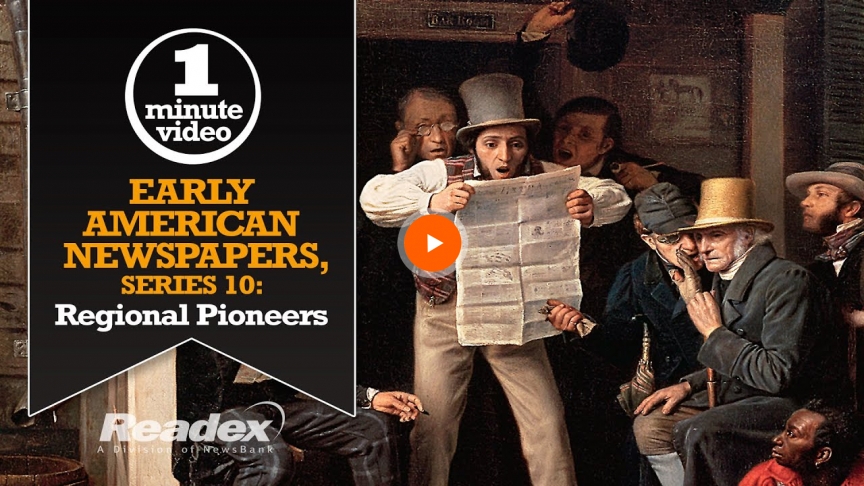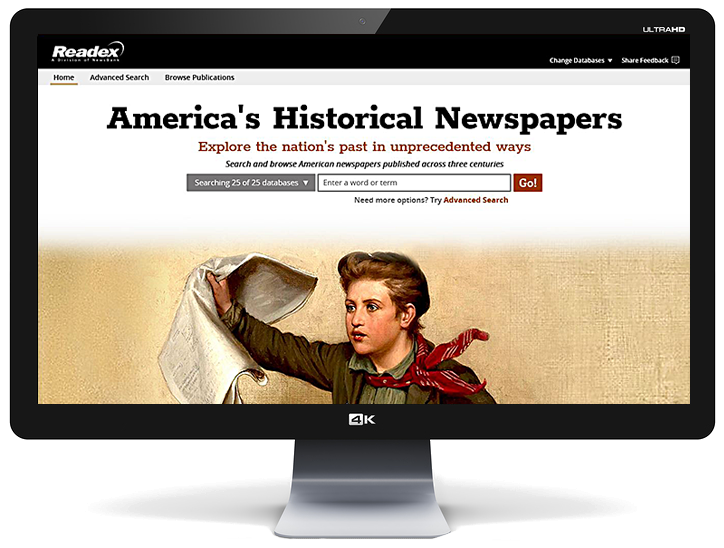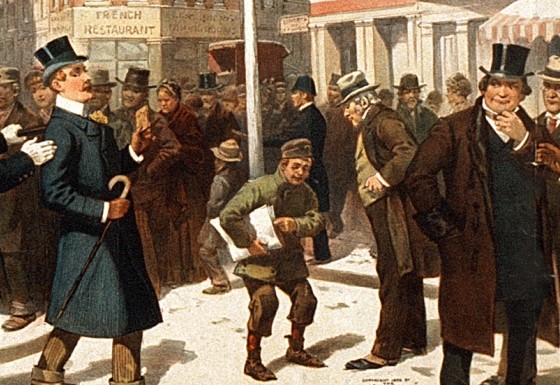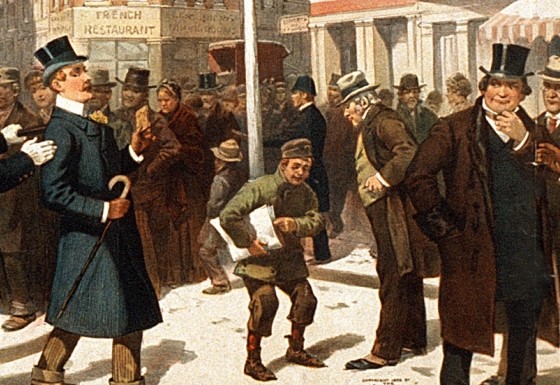
Early American Newspapers: Series 10, 1730-1900
Regional Pioneers
- Offers hundreds of essential titles from all 50 present states—now searchable for the first time
- Provides some of the earliest and rarest newspapers in each region of the United States
- Expands the political, geographical and chronological depth of Early American Newspapers
Early American Newspapers, Series 10, provides more than 440 titles from all 50 present states. Included are more than 60 18th-century newspapers that offer fresh insight into the Colonial and Revolutionary War eras. Among these are especially early and rare titles from such states as Florida, New York, North Carolina, and Ohio. The earliest 19th-century newspapers in Series 10 include more than 160 published before 1825, presenting new material on Westward expansion, the Early National era and other major topics. Also in this collection are more than 200 newspapers published between 1825 and 1900, including the first papers printed in the newly formed states of Arizona, Montana, Nebraska, and North Dakota.
Based on the renowned holdings of the American Antiquarian Society (AAS), Series 10 also includes titles from the Wisconsin Historical Society and other institutions. Notable titles include Pennsylvania Gazette (new issues for 1776-1793), one of the 18th-century’s most respected newspapers; Richmond Sentinel, which provides a rich portrayal of Virginia and Southern politics during the Civil War; Louisville Daily Courier, a pro-Confederacy paper in a crucial border state; Fort Smith Weekly New Era, a pro-Union, Republican paper from Arkansas; Chicago Republican, one of the region’s most influential newspapers during early years of the Reconstruction Era; Manchester Daily Mirror, one of New England’s most popular newspapers; Gallup Gleaner, which offers a vivid look at the intersection of New Mexico cultures prior to statehood; Los Angeles Daily Star and Oakland Daily Transcript, two early California dailies; Puget Sound Weekly Argus, featuring firsthand accounts of Washington’s booming timber and mining economies; and many others.
Superior bibliographic control
Like other Early American Newspaper series, Series 10 offers many significant titles listed in the authoritative bibliographies by Clarence S. Brigham and Winifred Gregory. A distinguished academic advisory board guided the title selection process.
An Archive of Americana® collection
As part of America’s Historical Newspapers, Early American Newspapers, Series 10, shares a common interface with all other Readex newspaper collections, enabling seamless searching with American Ethnic Newspapers, American Newspaper Archives, Caribbean Newspapers, and all previous series of Early American Newspapers.
The Early American Newspapers series is available within America’s Historical Newspapers.

Newspapers Struggle for Regional Dominance
Political, Business and Religious Newspapers of the 19th Century
“Readex, a division of NewsBank, has been publishing primary research materials for over 60 years and has partnered with the American Antiquarian Society for almost that long. The latest collaborative effort has resulted in the release of Series 10, 1730-1900 and Series 11, 1803-1899 in its Early American Newspapers collection…Series 10 adds more than 440 new titles, including Ben Franklin's Pennsylvania Gazette and many major political organs of their time, such as the National Intelligencer and The Chicago Republican. Series 11 adds 130 titles, including those such as the New York Herald, New York World, Cherokee Advocate, and the New Orleans Commercial Bulletin….
“Readex's expanding collection of historical US newspapers offers excellent breadth and depth—an unparalleled resource for all who pursue historical research in a great range of academic disciplines, as well as journalists, teachers, and genealogists. Summing Up: Highly recommended. All academic audiences; professionals/practitioners; general readers.”
— J. A. Knapp, Penn State University, reviewing Early American Newspapers, Series 10 and 11, in Choice (Dec. 2015)
“The Early American Newspapers collection contains over 2,000 newspapers of historical importance, both at the national and the local level, including the Pennsylvania Gazette, New York Herald, Boston Herald and Times-Picayune. Each series in the collection covers a different time span, and series can be selected individually or in combination to build a collection best suited to the needs of each institution’s users….Early American Newspapersuses the America’s Historical Newspapers interface, which makes it simple to search or browse….The simple search interface should make this database user-friendly for undergraduate researchers, while the thoughtful filtering options, as well as the sheer scope of the collection, will be a boon for more advanced researchers, such as graduate students and faculty.”
— Lindley Homol, Reference and Instruction Librarian, University of Maryland University College Library, in Reference Reviews (2015)
“Readex publishes respected subscription databases of full-text historical newspapers. Its America's Historical Newspapers collects and digitizes American newspapers; offerings include Early American Newspapers, which has recently released four additional series—series 6 (1741-1922), series 7 (1773-1922), series 8 (1844-1922), and series 9 (1832-1922). This collective addition adds 290 newspaper titles and over 4,300,000 pages to Early American Newspapers (series 1, CH, Apr'06, 43-4401; series 4 and 5, CH, Dec'12, 50-1798), bringing the complete collection to a substantial compilation of 2,000-plus newspaper titles from all 50 states, published between 1690 and 1922. Titles include valuable sources such as some 8,000 additional issues from New Orleans's Times-Picayune and some 15,000 issues from The Oregonian, now Oregon's largest newspaper. Other remarkable titles are Frank Leslie's Illustrated Newspaper and New York's The Daily Graphic--both heavily illustrated with hand-drawn graphics, making them a researcher's treasure. The complete list of additions is rich with titles of national and local importance.
“Libraries may purchase the entire collection or choose series, decades, or eras, in order to reflect a library's research needs. Readex's newspaper searching has a number of features that encourage precision and better results. The single search line can be expanded into a multiple-line search engine to better focus a complex research topic. Users may also narrow results by date, article type, language, state, and individual newspaper titles. The results present a small window of select information, with search terms in boldface for quick reading. Though other newspaper databases are available, the America's Historical Newspapers project is unique in the numbers of newspaper titles included, the number of individual issues included, and the inclusion of small local newspapers. Early American Newspapers is a real research gem for historians, all levels of college students, and genealogists. Summing Up: Highly recommended. Lower-level undergraduates through researchers/faculty; general readers.”
— C. W. Bruns, California State University-Fullerton, reviewing Early American Newspapers, Series 6-9, in Choice (July 2014)
“Readex has recently released Series 4 and 5 of this database, adding 268 newspaper titles and over 2,700,000 pages, all of which are available for full-text searching. These additional pages bring the current version of Early American Newspapers to over 1,000 historical newspaper titles with almost 9 million pages. Series 4 and 5 consist of newspapers from all 50 states and many diverse categories....Each additional release is a real bonanza to researchers....The Early American Newspapers database is unique among the many digitized newspaper collections for its size and for the inclusion of local newspapers; it is a functional database of real depth.
“Searching newspaper databases can be laborious, but Readex's features assist users in quickly locating the articles they need....These features are immensely useful when evaluating results. The Series 4 and 5, 1756-1922 component is the latest addition to an exciting product and a valuable tool for historians and students in a wide variety of fields...Summing Up: Highly recommended...”
—C. W. Bruns, California State University, Fullerton, reviewing Early American Newspapers, Series 4 and 5, in Choice (Dec. 2012)
"Readex has launched a new subscription-based Web site, America’s Historical Newspapers, that enables users to travel through time and call up issues of various newspapers to conduct, for example, a thorough study of the Civil War in the 1860s, analyze the stock market as it soared in the 1920s, or track the slugger Mickey Mantle’s baseball career throughout the 1950s. Using a simple search function, users can bring to life on their monitors the pages of an old newspaper from any major American city—and some small towns—and read about whatever person or event they choose.
"For example, one can call up any number of colonial-era newspapers to track the beginnings of the American Revolution in 1775 or search twentieth-century publications to investigate the 1941 Japanese attack on Pearl Harbor. The newspapers provide graphic accounts of history’s disasters and joyous stories of its triumphs. Do you want to know what the American people thought about Franklin D. Roosevelt’s famous “we have nothing to fear but fear itself” declaration? Look it up and read how ten different newspapers covered his first inaugural address in 1933. How electrifying was the 1927 baseball World Series? Call it up and read about it, game by game and inning by inning.
"The site allows users to race back in time, seeing how newspapers covered real drama. I went to the October 27, 1881, edition of the Tombstone Epitaph to read its account of the fabled gunfight at the O.K. Corral involving the legendary marshal Wyatt Earp. The lengthy, colorful story about the high noon shoot-out in Tombstone was just as melodramatic and colorful as the movies that depicted the battle. Happily, the story included a historical note not presented on film: that hundreds of men working in the Tombstone silver mines piled out of the mine shafts, 'like an invading army,' as the reporter wrote, when they heard news of the gun battle. Users can also access a national list of newspapers—organized by state—and compare how a paper in San Francisco covered the story with its treatment in a Boston publication....
"Overall, America’s Historical Newspapers is a fabulous tool for research. The new world of electronics and gadgetry may infuriate us (turn those cell phones off!) but here, in this Internet collection of historical newspapers, it is a wonder. I am researching a book on the Civil War and was able to call up dozens of 1860s newspapers. Full of vivid and stark accounts of the conflict, the newspapers provide the first draft of history, as they say—and a colorful one.
"The site will be extraordinarily helpful to scholars doing historical research, and it will also be rewarding for college and high school history teachers and students who want to use old newspapers as part of their study of the American story. Anyone with an Internet connection and wanderlust who wants to do a little journalistic time traveling can go to this site and come face to face with presidents, Oscar winners, Wall Street titans, and leaders of the women’s movement.
"And, as the American newspaper industry continues to shrink, it is always nice to go back in time and see it in its hearty majesty."
—Bruce Chadwick, Professor of History, Rutgers University, in Journal of American History (September 2010)
“Composite Score: 4.75 Stars (out of 5)....The initial search screen makes it very clear which searching options are available. One can immediately start searching using the Google-like search box and the drop-down menu of searching options, including Headline, Standard Title (i.e., publication title), and Title as published....The results list includes a wealth of information for each item, including title of publication; publication date; published as; location; headline, and article type....The results list also includes a thumbnail image (actually larger than a thumbnail) of a portion of the article. This facilitates research by making it easy to browse through and eliminate irrelevant items....
“Compared to other databases that sometimes make it difficult to find a list of titles included, this one gives you a list that is straightforward, easy to find, and includes useful details such as language, number of issues included, and start/end dates. The ability to sort the list by various categories is useful....The list of titles included is impressive. The publications list indicates details of what is included in each title, including name changes, etc. The fact that all titles are full-image enhances the use of the database for research.”
—Janice G. Schuster, Phillips Memorial Library, Providence College, in The Charleston Advisor (April 2010)
"A truly expansive archive of nearly 2,000 newspaper titles culled from all fifty states. At the time of this review, the fully searchable collection consists of three primary divisions, which together canvass the course of American history from 1690 to 1998. The first and largest of the three divisions, Early American Newspapers, is organized into seven series ranging from 1690–1922. Each series covers a range of years and geographic regions, which roughly expand in scope in conjunction with the geographic growth of the United States. A second division,African American Newspapers, 1827–1998, offers coverage of more than 170 years of African American history as recorded in 270 newspapers representing thirty-five states. The collection includes numerous historically significant titles, such as Freedom’s Journal, the first African American newspaper in American history, which was published in New York City from 1827–29. The third and final division, Hispanic American Newspapers, 1808–1980, is a by-product of the ‘Recovering the U.S. Hispanic Literary Heritage Project,’ a national program to locate, collect, and make available the written contributions of Hispanic Americans from the colonial period to the present. The collection includes hundreds of Hispanic American newspapers, including Spanish language and English titles printed in the United States."
—Daniel P. Barr, Robert Morris University, in Pennsylvania History: A Journal of Mid-Atlantic Studies (Winter 2010)
"Scholars and students of journalism history will find a rich resource of primary sources in Early American Newspapers, 1690-1922. The extensive database provides Web access to an expanding compilation of digitized newspapers published during 200-plus years….With the 2007 edition of series 4 and 5, the database numbers nearly 2,000 titles of full-text newspapers representing all fifty states and the District of Columbia. The collection contains an extensive array of papers, ranging from early colonial publications to regional weekly and metropolitan daily newspapers to the specialized press."
—Aleen Ratzalaff, Tabor College, in Journalism History (Spring 2008)
"Best of Reference 2007... 'You want a primary source from when?' One-stop shopping for full-text digital images from more than a thousand U.S. newspapers published from 1690 to 1922. Zoom in and out of particular time periods with a score of handy limit options."
—Branch Libraries, The New York Public Library (May 2007)
"Most Improved Product....exploding with new content, a much improved user interface..."
—The Charleston Advisor (October 2006)
“Readex has long been the name associated with collecting and preserving documents that define and describe the country’s early heritage. Early American Newspapers (EAN), with bibliographic and full-image access to nearly two centuries’ worth of local papers (from 23 East Coast and Midwestern states and the District of Columbia), represents one of the major components of its ‘Archive of Americana’ suite of digital collections….
“It’s as if the contents of hundreds of historical societies all across America were put on display, and a glance at the list of titles—from the Cahawba Press and Alabama Intelligencer(Cahawba, AL) to The Bee (Hudson, NY) to the lone issue of People’s Friend (Danville, KY)—should be enough to give scholars and historians a serious case of goose bumps….
“Institutions acquiring multiple Archive collections receive a discount; those that own the microform receive an additional discount-an approach we warmly applaud….
“EAN's content possesses a local flavor that the other resources reviewed here cannot come close to matching.”
—Gail Golderman and Bruce Connolly, Union College, in Library Journal-supplement Net Connect (Fall 2005)
"...Rapid access to newspapers spanning centuries. ... Researchers in academic, public and historical libraries will save time with this resource. … Early American Newspapers, Series I is the researcher's choice to complement Early American Imprints, Series I: Evans, 1639-1800 and Early American Imprint Series II: Shaw-Shoemaker, 1801-1819."
—Jetta Carol Culpepper, Special Programs Librarian, Murray State University Libraries and the College of Education, in Reference Reviews (November 2005)
"Early American Newspapers is a digitized, full image, completely searchable electronic database of newspapers that chronicle the rich and intriguing history of the United States' early years. The collection focuses on titles published in the 18th century but includes material from 1690 through 1876. This substantial database includes 617 newspaper titles, though many of the titles are far from complete. It features 1,344,099 pages as of 2005, with more to be added. The newspapers are primarily from a collection owned by the American Antiquarian Society. Series I includes newspapers from 23 eastern states and the District of Columbia. Series 2 and Series 3, covering other parts of the country, have recently been released.
“Researchers who remember working with clunky microfilm, with all its limitations, will be ecstatic about this product's ease of use and dynamic search capabilities. The search engine is highly intuitive.
“It is possible to combine Boolean operators in both simple and advanced searches and to limit to categories as varied as elections, legislation, poetry, letters, shipping news, and advertisements. Genealogical researchers will enjoy being able to limit searches to death or matrimony notices. Especially valuable with this type of database is the capability of dealing with the variant spellings so common in early American primary materials. The digitized images vary in quality but tend to be amazingly good, given that they are copies of deteriorating newsprint. This unique source of primary materials will be of great interest to larger public libraries and to academic libraries within the geographic areas covered. Summing Up: Highly recommended. Lower-level undergraduates through faculty/researchers; general readers.”
—C. W. Bruns, California State University, Fullerton, in Choice (April 2006)
“The availability of the Early American Newspapers database of thousands of Manhattan newspapers from that period also helped—and I read them all! (This is slightly less impressive than it sounds; each issue was normally only 4 pages.) But that's the challenge if you're trying to a write a narrative history that has anything like a novelistic level of detail—it's not just the big stuff, like the details of the case in itself, it's the little stuff like what color was someone's bedstead painted, what did they eat for dinner that night, whose house down the street got robbed the week before, which juror ran a grocery with another juror a decade earlier, that sort of thing. You can't get that from standard accounts; it's only diaries and searchable scanned newspapers that can dredge up that stuff.”
—Paul Collins, author of Duel with the Devil: The True Story of How Alexander Hamilton and Aaron Burr Teamed Up to Take On America's First Sensational Murder Mystery, on Fine Books & Collections.com (Jan. 2015)
“America’s Historical Newspapers enabled me to trace the different contemporary and then later uses of the ‘scalping’ hoax. By way of background, let me point out that Franklin was profoundly troubled that the British military was paying Native peoples to create devastation on British Americans’ homes and to kill the people. Franklin had spent much of his time while in Pennsylvania (decades earlier) figuring out how best to negotiate peacefully with Indians. So he was outraged when the Indians became (by necessity and in an effort to preserve their own sovereignty) involved in the fray between Britons in North America and those in England. The Readex database made it possible for me to discover the posthumous uses to which Franklin’s hoax had been put, and, with terrible irony, I discovered that it was used to promulgate a form of Indian-hating by Americans in North America. The original target, British peoples in England, was lost, and the Indians received the central, negative thrust of the hoax. I think Franklin would have found this appalling. So I traced the uses of the hoax and made a record of it, so that others might see how periodical circulation takes on a life of its own."
—Carla Mulford, Associate Professor of English at Penn State University and Founding President of the Society of Early Americanists
“Between the years 1998-2008 my large research team had the good fortune to be funded by a generous grant from Mars, Incorporated, to investigate the culinary, medicinal, and social history of chocolate....Our research team drew extensively on Colonial Era and Federal Era documents available through Early American Newspapers, especially chocolate/cacao-related advertisements, articles, price currents, obituaries, and shipping news documents. As a scholar who formerly spent months using microfilm documents—winding and re-winding reels searching for specific documents on specific dates—I report here that the new technologies available through Readex have made my work and that of my students a hundred times easier. Now, with a click of our computer ‘mice,’ team members can retrieve thousands of documents that previously would have taken weeks to amass.”
—Louis E. Grivetti, co-editor of Chocolate: History, Culture, and Heritage (Wiley, 2009)
“The advent of Readex’s online edition of Early American Newspapers opens new avenues to research and dramatically reduces the time to do that research. Now, scholars not only can locate the original articles in context, they can also study how an article might have changed as it was reprinted in another newspaper....Early American Newspapers often allows scholars to find details when they only have general information.”
—Norman Desmarais, author of Battlegrounds of Freedom, The Guide to the American Revolutionary War in Canada and New England and The Guide to the American Revolutionary War in New York
“Despite the large number of convicts who were shipped across the Atlantic, finding information about them can be a challenge. Most of the convicts were illiterate, and many of them tried to hide their criminal past by changing their names and moving away after serving out their terms. The historian has to do some real digging to fill in the lives of these little-known men and women, and Readex’s Early American Newspapers is a tremendous help in this regard.
“Eighteenth-century American newspapers often carried announcements of convict ships leaving Great Britain and arriving in America with prisoners for sale as servants. Newspapers ran numerous advertisements for runaway convicts that describe in detail their clothing and bodily marks—faces pitted from small pox being a common characteristic. Sometimes the ads indicate their skills or behavioral tendencies, such as “addicted to boasting and telling of lies,” “loves liquor” or has “a very remarkable way of staring any body in the face that speaks to him.” Sometimes convict servants are described wearing an iron collar or handcuffs, and many times they escaped in pairs or in groups, occasionally in the company of an African slave.
—Anthony Vaver, publisher of EarlyAmericanCrime.com
“One afternoon, though, I discovered a unique online database of primary sources: Early American Newspapers, Series 1, 1690-1876. No longer was insufficient research material a problem. With access to almost any colonial newspaper that I desired, I now had a library of pertinent primary information at my fingertips. Although I could give several examples that speak to the quality of research provided by these sources, three articles suffice to illustrate how this searchable database offered me unique insight into the New Yorkers’ reactions....These articles only begin to scratch the surface of the type of research made possible by the seven online series of Early American Newspapers. The amount of valuable information contained in these issues and the ease with which it can be browsed and searched cannot be overemphasized. In my case, just as the Tea Party was not confined to Boston, thanks to the digitization of Early American Newspapers, neither was my research limited to the print and microfilm materials held by my own small institution’s library.”
—David Brooks, Graduate, Taylor University, May 2010
“Readers of the Washington, D.C. newspaper The Daily National Intelligencer witnessed a strange and disturbing transformation in 1847, when the nation’s most popular literary character freely admitted that he had become a greedy, cynical killer. Soon enough this beloved American hero, whose name was synonymous with Yankee Doodle, would threaten to stage a military coup to seize the Capitol and overthrow Congress! Readers of the Early American Newspapers archive can follow along, gleaning important hints to decoding contemporary political rhetoric.”
—Aaron McLean Winter, National Tsing Hua University
"We are avid users of Early American Newspapers for our research on the Jefferson Papers and have been thrilled by its increased accessibility in a digital edition. Early American Newspapers has been of enormous value to us."
—Martha J. King, Ph.D., Associate Editor, Papers of Thomas Jefferson, Princeton University
"Readex has put together a wondrous, easy-to-search database from the world's most important repositories of early American newspapers. Historians and other scholars who want to shave years off their research would do well to ask their college or university to purchase it."
—Robert L. Paquette, Publius Virgilius Rogers Professor of American History, Hamilton College
“My students are ecstatic about Readex’s digital Early American Newspapers. I’m delighted too, remembering the many hours I spent squinting over a microcard reader as I researched what became my first published article. At the time, I considered it a miracle that my small state university had a microcard reader, even though in summer condensation on the glass produced even deeper fog than the words themselves. Digitization will help democratize scholarship, but in the right hands it will also produce more thorough and imaginative research.”
—Laurel Thatcher Ulrich, Phillips Professor of Early American History, Harvard University
“How jealous I am of the students who will be able to use this wonderful resource! The digital version of Early American Newspapers gives them an unfair advantage over all previous generations of scholars who had to spend months or even years seeking-and perhaps never finding-what can now be found with a few keystrokes. One five-minute search on ‘Washington Irving’ made visions of an article dance before my eyes. I turned up not only reviews of his works and accounts of his travels, but an article about the controversy surrounding Irving’s selection to a committee charged with designing a memorial to Shakespeare in London. (‘It does appear,’ wrote a London editor, ‘that a national monument could have been raised to Shakspeare without selecting as a Committee-man, a member of a republic which has denationalized itself.’) Who knew?”
—Benjamin Reiss, Associate Professor of English, Tulane University
“Digital Early American Newspapers is extremely valuable for scholars, teachers and students. I was able to search for specific individuals, commodities and objects, helping me to complete a study of one product and its distribution and consumption in America. Before this digitization, time would not permit me to search for goods of a certain name and merchants of a particular firm. Nor could I before scan across cities in search of specific debates on specific topics. For an American Revolution course I teach, I am now able to present in my lectures and handouts information on how debates over, for example, luxury ramified and endured after the 1780s and early 1790s.
“Early American Newspapers also allows more effective research by my students on course-essay topics, such as one paper on the fear of piracy in the late 18th century. For certain subjects in material, economic and literary history, extracting needles from haystacks is key, and this digital collection will offer that ability. I especially like that it will allow graduate students to break their current focus on the Middle Colonies and States, rerouting attention to other cities and problems and facilitating previously difficult cross-urban comparisons.”
—David Hancock, Professor; Director, Atlantic Studies Initiative, University of Michigan, Ann Arbor
“With its digital Early American Newspapers collection, Readex has produced an excellent new resource. A religion department colleague has found articles that he did not know existed about an obscure Protestant sect he’s studying. I’ve been able to continue work in the ‘Massachusetts Spy’ that I’d had to set aside for lack of time to visit the microfilm reader, and a graduate student studying women criminals has been able to vastly expand her research base. We are all very impressed. This Web-based archive is a beaut!”
—Woody Holton, Associate Professor of History, University of Richmond
"The Early American Newspapers database is a digital miracle that will revolutionize the way in which scholars conceive of and undertake research. Ideas buried in crumbling and hard-to-find newspapers are now available with the click of a mouse. Not only is it possible to identify the emergence of ideas within specific texts and contexts, but it is now also practical, for the first time, to trace their diffusion through space and time, identifying plagiarisms, noting piracies, documenting permutations and revealing the structure of hitherto invisible networks of communication."
—Leon Jackson, Associate Professor of English, University of South Carolina
“The Readex digital Early American Newspapers (1690-1876) will revolutionize the way American history is taught and studied. Until now, only an intrepid few scholars have mined these phenomenal resources. The absence of any easily used indexes, the tedium of endless hours before the microfilm reader, and the simple scarcity of some of these primary sources has made truly comprehensive work in early American newspapers extremely difficult.
“With this new on-line resource, scholars and students alike will be able to easily and efficiently search these texts. And they will be able to do so in a way hitherto only dreamed of. Instead of focusing on modest runs, perhaps several years, of a very limited number of papers, they will now be able to search decades of a much larger variety of newspapers. If the recent work of researchers such as Jeffrey L. Pasley and David Waldstreicher is any indication, the yield of this new research will be monumental. We will have a whole new sense of exactly what it was early Americans knew about themselves and their world. For the first time, students too will be able to explore once pedestrian documents in ways never before possible. Imagine a research project on Jefferson’s first inauguration in which students can easily survey dozens of newspaper accounts. The possibilities boggle the mind.”
—Edward G. Gray, Professor of History, Florida State University
“Digital Early American Newspapers will revolutionize research in early American history by allowing full-text searches of a huge and constantly growing number of early newspapers ranging over centuries of time and the whole of the nation. No indexes exist for these materials. In the past, one had to pick a specific paper in a specific time and place and simply slog through it. It could easily take a couple days to thoroughly read one year of one daily newspaper, with no guarantee that anything related to one’s research question would be found. The process then had to be repeated paper after paper, year after year. Because of the low signal-to-noise ratio and the intense physical demands (on the eyesight especially) of this sort of research, many scholars and most students of early American history have avoided newspapers if they could, even though newspapers are by far the most extensive and useful source available on many political, cultural, and economic topics. The wide dissemination of the Early American Newspapers database should change all that.”
“Now research projects that once took weeks will be performed in an afternoon. New historical interpretations will arise in many areas simply because more historians will be able find out for the first time what was in the periodical press. In addition, the research capacities and consequent professional development of students will greatly expand.”
—Jeffrey L. Pasley, Associate Professor of History, University of Missouri-Columbia
“Explore your early American ancestors and the America of yesterday!... A new invaluable resource.... Based largely on Clarence Brigham’s ‘History and Bibliography of American Newspapers, 1690-1820,’ this collection offers a fully text-searchable database of over one million pages, including cover-to-cover reproductions of historic newspapers! It contains a comprehensive listing of marriage, death, and court records found in early American periodicals such as the Boston Gazette, Gazette of the United States, New York Evening Post, and many more. For genealogists and scholars alike, Early American Newspapers, 1690-1876, offers an unprecedented look back into the extraordinary past of the United States!"
—The New England Historic Genealogical Society Web Site
“An essential source for early Americanists now available in a user-friendly format. Makes research for scholars and students much easier and more rewarding.”
—Graham Hodges, George Dorland Langdon Jr. Professor of History, Colgate University
(Updated July 2016)
Pennsylvania Gazette (Philadelphia, 1776-1793)
- Benjamin Franklin’s Pennsylvania Gazette was one of the most respected and influential newspapers in America during these decades. This rare run of the Pennsylvania Gazette complements the earlier issues in Early American Newspapers, Series 1 and 2.
National Intelligencer, Tri-Weekly Edition (Washington, D.C., 1813-1828) and United States Telegraph, Daily Edition (Washington, D.C., 1826-1833)
- During these decades, these papers were the two leading political organs in Washington. The National Intelligencer was founded to support the Jefferson administration, and was for years the official publication for Congressional reports. After the election of Andrew Jackson in 1829, power shifted to the United States Telegraph. Early American Newspapers, Series 10, offers researchers access to the opposing viewpoints of these powerful papers for the first time. This tri-weekly edition of the National Intelligencer complements other editions in Early American Newspapers, Series 1 and 6; this daily edition of the United States Telegraph complements the tri-weekly edition in Series 6.
Los Angeles Daily Star (1872-1876) and Oakland Daily Transcript (1869-1876)
- These two early California dailies are the earliest titles in their cities to appear in any Early American Newspapers series to date.
Frank Leslie’s Illustrirte Zeitung (New York, New York; 1858-1866)
- Leslie’s newspaper was the most lavishly illustrated newspaper in America. This German-language edition offers researchers unparalleled illustrative Civil War battle maps, portraits, and military panoramas.
Christian Watchman (Boston, Massachusetts; 1821-1850)
- Published in association with the Baptist Missionary Society, the Christian Watchman was 0ne of the earliest and most influential religious newspapers in America. Religious news included reports of Bible, missionary, and tract societies, both in the U.S. and abroad. Non-religious material included general news, poetry, book reviews, biography, and articles on history, education, and agriculture.
Helena Weekly Herald (Helena, Montana; 1872-1888)
- This rare run of the Helena Weekly Herald covers the Montana Territory during the tragic Indian conflicts of the era, including the Battle of the Little Bighorn.
Western Spy and Hamilton Gazette (Cincinnati, Ohio; 1799-1805)
- When Ohio became a state in 1803, the Western Spy was one of the only two newspapers within its borders.
Louisville Daily Courier (Louisville, Kentucky; 1853-1868)
- As a pro-Confederacy paper in the crucial border state of Kentucky, the Louisville Daily Courier’s coverage of the Civil War in Series 10 will be of particular interest to researchers.
Boston Daily Bee (Boston, Massachusetts; 1843-1857)
- As the official organ of the controversial American Party, this full run of the Boston Daily Bee offers a detailed look at the principles that divided the many political factions competing for power during the decades leading up to the Civil War.
Trump of Fame (Warren, Ohio; 1816-1861)
- An early Free-Soil party organ, this paper's coverage and shifting political views during this era provide an inside look at the political history of the Free-Soil Party, the Whig Party, and the emerging modern Republican Party.
Detroit Gazette (Detroit, Michigan; 1817-1830)
- One of the first newspapers in Michigan, John P. Sheldon’s Detroit Gazette offers a rare first-hand account of the region’s early history. All of the stories were printed in English on its first three pages; the most important stories were re-printed in French on page four.
Fort Smith New Era (Fort Smith, Arkansas; 1869-1880)
- “The Oldest Republican Newspaper in the Now Defunct Confederacy” is how publisher Valentine Dell described his confrontational Fort Smith Weekly New Era after the Civil War. The paper’s politically brave position as a pro-Union, Republican paper in the South will be of particular interest to historians of the Reconstruction period.
Manchester Daily Mirror (Manchester, New Hampshire; 1851-1863)
- Under publisher John B. Clarke, the Daily Mirror became one of the most popular and influential newspapers in New England. The run here covers the rise of the paper, the contentious politics of the region during the decade preceding the Civil War, and the turmoil that would follow as the War began.
Gallup Gleaner (Gallup, New Mexico; 1889-1896)
- Founded in 1881 as a major Territorial rail-head on the Atlantic and Pacific Railroad, Gallup was surrounded by several Native American tribes. The Gallup Gleaner offers a vivid look at the intersection of cultures in New Mexico before it became a state in 1912.
Sentinel (Richmond, Virginia; 1863-1866)
- The Richmond Sentinel was founded in 1863 to support the Jefferson Davis administration. The paper’s editorial battles with the anti-Davis papers in the Confederate capitol offer a rich vision of Southern politics during the Civil War.
Carillon (New Orleans, Louisiana; 1869-1875)
- This combative French-language newspaper (title in English: “The Alarm Bell”) was published as a reaction to the hardships of Reconstruction.
Columbian Museum and Savannah Advertiser (Savannah, GA, 1800-1822)
- One of the earliest newspapers in Georgia’s oldest city, the Columbian Museum and Savannah Advertiser offers a rare first-hand account of the region during the Early National period.
Daily Inter Ocean (Chicago, Illinois; 1865-1871)
- One of the most influential newspapers in Chicago during this era, the Inter Ocean employed Samuel Clemens (Mark Twain) as a correspondent in 1868. The Chicago Republican was relaunched as the Chicago-based Inter Ocean in 1872.
Puget Sound Weekly Argus (Port Townsend, Washington; 1870-1883)
- Located at the Northern entrance to Puget Sound, Port Townsend was one of the major trading ports in the Pacific Northwest during this era. The Argus provides a first-hand account of the booming timber and mining economies of the period, and of the ongoing conflicts with the many Native American tribes in the region.
Leavenworth Daily Conservative (Leavenworth, Kansas; 1861-1865)
- A staunch Conservative voice in Kansas during this era, the Daily Conservative placed correspondents in every county in the state, and offers a detailed history of Kansas during the turmoil of the Civil War.
Alaska Herald (San Francisco, California; 1868-1874)
- The first newspaper to focus its coverage on Alaska, the Alaska Herald was founded by Agapius Honcharenko, who had fled Russia on charges of advocating the liberation of serfs. Honcharenko’s paper saw a great future for the Alaskan region; early issues included Russian translations of the United States Constitution.
Each of these titles in this series represents the earliest newspaper in their state to appear to date in Early American Newspapers:
- New York Gazette (New York, New York; 1730-1738)
- North Carolina Gazette (New Bern, North Carolina; 1775)
- East Florida Gazette (St. Augustine, Florida; 1783)
- Centinel of the North Western Territory (Cincinnati, Ohio; 1795)
- Le Telegraph et le Commercial Advertiser (New Orleans, Louisiana; 1803-1804)
- Mississippi Messenger (Natchez, Mississippi; 1804-1808)
- Madison Gazette (Huntsville, Alabama; 1813-1815)
- Mobile Gazette (Mobile, Alabama; 1813-1820)
- Detroit Gazette (Detroit, Michigan; 1817-1830)
- Sandwich Island Gazette and Journal of Commerce (Honolulu, Hawaii; 1836-1839)
- Omaha Arrow (Omaha, Nebraska; 1854)
- Weekly Arizonian (Tubac, Arizona; 1859-1860)
- Frontier Scout (Fort Rice, North Dakota; 1865)
Stay in Touch
Receive Readex news, invitations, and special offers
Sign UpBy clicking "Sign Up", you acknowledge that you have read and understand our Privacy Policy and Terms of Use.




















































